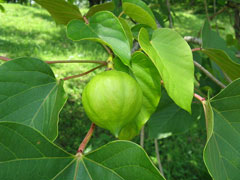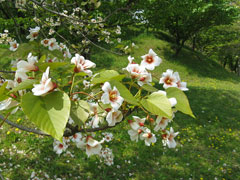 |
|
http://commons.wikimedia.org/wiki/User:KENPEI |
 |
| http://commons.wikimedia.org/wiki/User:KENPEI |
Translate this page:
Summary
Bloom Color: White.
Main Bloom Time: Early spring, Late spring, Mid spring. Form: Rounded.
Physical Characteristics

 Aleurites fordii is an evergreen Tree growing to 7 m (23ft) at a fast rate.
Aleurites fordii is an evergreen Tree growing to 7 m (23ft) at a fast rate.
See above for USDA hardiness. It is hardy to UK zone 10 and is frost tender. It is in leaf all year, in flower in March, and the seeds ripen from September to November. The species is monoecious (individual flowers are either male or female, but both sexes can be found on the same plant) and is pollinated by Bees. The plant is self-fertile.
Suitable for: light (sandy) and medium (loamy) soils and prefers well-drained soil. Suitable pH: mildly acid soils. It can grow in semi-shade (light woodland) or no shade. It prefers moist soil.
UK Hardiness Map
US Hardiness Map
Synonyms
Plant Habitats
Woodland Garden Secondary; Dappled Shade; South Wall. By. West Wall. By.
Edible Uses
Edible Parts: Oil Seed
Edible Uses: Oil
Seed[105]. There are no more details but the report should be treated with caution since the oil from the seed is said to be poisonous[65].
References More on Edible Uses
Medicinal Uses
Plants For A Future can not take any responsibility for any adverse effects from the use of plants. Always seek advice from a professional before using a plant medicinally.
Antibacterial Antiphlogistic Emetic Vermifuge
The oil from the seed is used externally to treat parasitic skin diseases, burns, scalds and wounds[218]. The poisonous oil is said to penetrate the skin and into the muscles, when applied to surgical wounds it will cause inflammation to subside within 4 - 5 days and will leave no scar tissue after suppressing the infection[218]. The plant is emetic, antiphlogistic and vermifuge[147, 218]. Extracts from the fruit are antibacterial[218].
References More on Medicinal Uses
The Bookshop: Edible Plant Books
Our Latest books on Perennial Plants For Food Forests and Permaculture Gardens in paperback or digital formats.

Edible Tropical Plants
Food Forest Plants for Hotter Conditions: 250+ Plants For Tropical Food Forests & Permaculture Gardens.
More

Edible Temperate Plants
Plants for Your Food Forest: 500 Plants for Temperate Food Forests & Permaculture Gardens.
More

More Books
PFAF have eight books available in paperback and digital formats. Browse the shop for more information.
Shop Now
Other Uses
Insecticide Oil
The seed contains up to 58% of a superior quick-drying oil that is used in the manufacture of lacquers, varnishes, paints, linoleum, oilcloth, resins, artificial leather, felt-base floor coverings, greases, brake-linings and in clearing and polishing compounds. Tung oil products are used to coat containers for food, beverages, and medicines; for insulating wires and other metallic surfaces, as in radios, radar, telephone and telegraph instruments[1, 46, 57, 61, 74, 269]. During World War II, the Chinese used tung oil for motor fuel. It tended to gum up the engines, so they processed it to make it compatible with gasoline. The mixture worked fine[269]. The oil is very resistant to weathering[171]. The oil is said to have insecticidal properties[218]. The fruit contains between 14 - 20% oil, the kernel 53 - 60% and the nut 30 - 40%[218, 269]. The oil contains 75 - 80% a-elaeo stearic, 15% oleic-, ca 4% palmitic-, and ca 1% stearic-acids[269]. Tannins, phytosterols, and a poisonous saponin are also reported[269]. Trees yield 4.5 - 5 tonnes of fruit per hectare[269]. Tung trees usually begin bearing fruit the third year after planting, and are usually in commercial production by the fourth or fifth year, attaining maximum production in 10 - 12 years. Average life of trees in United States is 30 years. Fruits mature and drop to ground in late September to early November. At this time they contain about 60% moisture. Fruits must be dried to 15% moisture before processing. Fruits should be left on ground 3 - 4 weeks until hulls are dead and dry, and the moisture content has dropped below 30%. Fruits are gathered by hand into baskets or sacks. Fruits do not deteriorate on ground until they germinate in spring[269].
Special Uses
References More on Other Uses
Cultivation details
One report says that the plant is very tolerant of soil conditions[74]. It is easily grown in a loamy soil but the plants are unable to withstand much frost[1]. Requires a lime-free soil[200]. The Tung tree is reported to tolerate an annual precipitation of 64 - 173cm, average temperatures ranging from 18.7 - 26.2°C, and a pH of 5.4 - 7.1[269]. Tung trees are very exacting in climatic and soil requirements[269]. They require long, hot summers with abundant moisture, with usually at least 112 cm of rainfall rather evenly distributed through the year[269]. Trees require 350 - 400 hours in winter with temperatures 7.2°C or lower - without this cold requirement, trees tend to produce suckers from the main branches. Vigorous but not succulent growth is the most cold resistant - trees are susceptible to cold injury when in active growth[269]. Production of tung is best where day and night temperatures are uniformly warm. Much variation reduces tree growth and fruit size. Trees grow best if planted on hilltops or slopes, as good air-drainage reduces losses from spring frosts. Contour-planting on high rolling land escapes frost damage. Tung makes its best growth on virgin land. Soils must be well-drained, deep aerated, and have a high moisture-holding capacity to be easily penetrated by the roots. Green manure crops and fertilizers may be needed. Dolomitic lime may be used to correct excessive acidity; pH 6.0 - 6.5 is best; liming is beneficial to most soils in the Tung Belt, the more acid soils requiring greater amounts of lime[269]. Trees are not very cold hardy outdoors in Britain[200]. Another report says that they are fairly hardy[74]. A very ornamental tree[74], it is cultivated in China for the oil contained in its seed[74, 109, 269]. There are some named varieties[269]. Seedlings generally vary considerably from parent plants in growth and fruiting characters. Seedlings which have been self-pollinated for several generations give rather uniform plants[269]. Only 1 out of 100 selected 'mother' tung trees will produce seedlings sufficiently uniform for commercial planting[269]. Usually seedling trees outgrow budded trees, but budded trees produce larger crops and are more uniform in production, oil content and date of fruit maturity[269]. Special Features:Not North American native, Invasive, All or parts of this plant are poisonous, Attractive flowers or blooms.
References Carbon Farming Information and Carbon Sequestration Information
Temperature Converter
Type a value in the Celsius field to convert the value to Fahrenheit:
Fahrenheit:
The PFAF Bookshop
Plants For A Future have a number of books available in paperback and digital form. Book titles include Edible Plants, Edible Perennials, Edible Trees,Edible Shrubs, Woodland Gardening, and Temperate Food Forest Plants. Our new book is Food Forest Plants For Hotter Conditions (Tropical and Sub-Tropical).
Shop Now
Plant Propagation
Seed - sow March/April in a warm greenhouse. When large enough to handle, prick the seedlings out into individual pots and grow them on for at least the first winter in a greenhouse. Plant out in early summer and give the plants some protection from the cold for their first winter outdoors. Tung seed are normally short-lived and must be planted during the season following harvest. Seeds are best hulled before planting, as hulls retard germination. Hulled seed may be planted dry, but soaking in water for 5 - 7 days hastens germination. Stratification, cold treatment or chemical treatment of seeds brings about more rapid and uniform germination. Dry-stored seed should be planted no later than February; stratified seed by mid-March; cold-treated and chemical treated seed by early April[269]. Cuttings of mature wood in a frame[200]. Most successful budding is done in late August, by the simple shield method, requiring piece of budstock bark, including a bud, that will fit into a cut in the rootstock bar[269]. A T-shaped cut is made in bark of rootstock at point 5 - 7.5 cm above ground level, the flaps of bark loosened, shield-bud slipped inside flaps and the flaps tied tightly over the transplanted bud with rubber budding stripe, 12 cm long, 0.6 cm wide, 0.002 thick. After about 7 days, rubber stripe is cut to prevent binding. As newly set buds are susceptible to cold injury, soil is mounded over them for winter. When growth starts in spring, soil is pulled back and each stock cut back to within 3.5 cm of the dormant bud. Later, care consists of keeping all suckers removed and the trees well-cultivated[269]. Spring budding is done only as a last resort if necessary trees are not propagated the previous fall[269].
Other Names
If available other names are mentioned here
Native Range
TEMPERATE ASIA: China (Anhui Sheng, Zhejiang Sheng, Fujian Sheng, Henan Sheng, Hunan Sheng, Hubei Sheng, Jiangxi Sheng, Jiangsu Sheng, Guangdong Sheng, Guizhou Sheng, Shaanxi Sheng, Sichuan Sheng, Yunnan Sheng, Guangxi Zhuangzu Zizhiqu, Hainan Sheng) TROPICAL ASIA: Myanmar, Vietnam (north)
Weed Potential
Right plant wrong place. We are currently updating this section.
Please note that a plant may be invasive in one area but may not in your area so it's worth checking.
Conservation Status
IUCN Red List of Threatened Plants Status :

Growth: S = slow M = medium F = fast. Soil: L = light (sandy) M = medium H = heavy (clay). pH: A = acid N = neutral B = basic (alkaline). Shade: F = full shade S = semi-shade N = no shade. Moisture: D = dry M = Moist We = wet Wa = water.
Now available:
Food Forest Plants for Mediterranean Conditions
350+ Perennial Plants For Mediterranean and Drier Food Forests and Permaculture Gardens.
[Paperback and eBook]
This is the third in Plants For A Future's series of plant guides for food forests tailored to
specific climate zones. Following volumes on temperate and tropical ecosystems, this book focuses
on species suited to Mediterranean conditions—regions with hot, dry summers and cool, wet winters,
often facing the added challenge of climate change.
Read More
Expert comment
Author
Hemsl.
Botanical References
109200266
Links / References
For a list of references used on this page please go here
Readers comment
© 2010, Plants For A Future. Plants For A Future is a charitable company limited by guarantee, registered in England and Wales. Charity No. 1057719, Company No. 3204567.